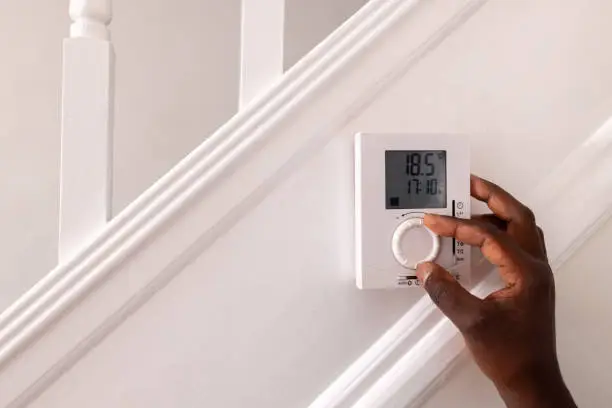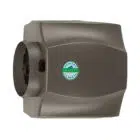
Table of Contents
Winter is a beautiful season, especially in Canada, with its stunning snow-covered landscapes and cozy indoor moments. But as the temperatures drop, so does the humidity level in our homes, leading to a host of issues that can affect our comfort and health. So, what’s the best humidity level in the winter season? Let’s dive into this topic and find out how to keep your indoor environment just right.
The Problems of Low Humidity Level in Winter
When winter arrives, the cold air outside can’t hold much moisture, and as we heat our homes, the air inside becomes even drier. This low humidity level in winter can lead to several problems that many of us experience every year.
Firstly, dry air can wreak havoc on our health. It can cause dry skin, chapped lips, and irritated eyes. You might also notice an increase in respiratory issues, such as dry throat and nose bleeds. For people with allergies or asthma, dry air can exacerbate symptoms, making the winter months particularly uncomfortable.
But it’s not just our bodies that suffer. Our homes and belongings can also take a hit. Wooden furniture and floors can crack and warp, and even musical instruments like pianos and guitars can go out of tune or suffer damage. Additionally, you might find that static electricity becomes more of an issue, giving you those annoying little shocks when you touch certain objects or even other people.
What Is the Optimal Humidity Level?

So, what’s the magic number? Experts generally agree that the ideal indoor humidity level in winter should be between 30% and 50%. This range is comfortable for most people and helps to protect your home and belongings.
Keeping your home’s humidity level within this range can alleviate many of the problems associated with dry air. It’s a sweet spot where the air isn’t too dry to cause health issues or damage to your home, but not so humid that you risk condensation on windows and walls, which can lead to mold growth.
If you need to reduce home humidity, you can find 10 easy ways in our previous article.
https://thehvacservice.ca/how-to-reduce-indoor-humidity-10-easy-ways/
Benefits of Maintaining the Right Humidity Level
Maintaining the right humidity level in your home during winter comes with numerous benefits. Let’s explore some of the key advantages:
Improved Health and Comfort
When your home’s humidity level is at the right level, you’ll notice a significant improvement in your overall comfort. Your skin will feel less dry, and you’ll be less likely to experience irritations in your eyes, nose, and throat. Respiratory conditions, such as asthma and allergies, can also be better managed, as moist air helps to keep your airways clear.
Protection for Your Home and Belongings
Proper humidity levels can help preserve the condition of your home. Wooden floors, furniture, and musical instruments will be less prone to cracking and warping. This can save you money on repairs and replacements in the long run.
Energy Efficiency
Did you know that maintaining the right humidity level in winter can also help with your home’s energy efficiency? When the air is too dry, it can actually make you feel colder, leading you to crank up the heat. By keeping the humidity at an optimal level, you can feel warmer at lower temperatures, potentially lowering your heating bills.
Tips for Maintaining Humidity Levels
Now that we understand the importance of proper humidity levels, how do we achieve this balance in our homes during winter? Here are some practical tips to help you maintain the ideal humidity level in winter:
Use a Humidifier
Investing in a good humidifier is one of the best ways to add moisture to the air in your home. There are various types of humidifiers available, including portable units for individual rooms and whole-house systems that can be integrated with your HVAC system. Choose the one that best suits your needs and budget. A furnace humidifier is a great option for whole-house humidification, as it works directly with your heating system to maintain the proper humidity level throughout your home.
Choose your perfect furnace humidifier at our official website via the link before.
Monitor Humidity Levels
To ensure you’re maintaining the right humidity levels, use a hygrometer to measure the moisture in the air. This small device is affordable and easy to use, giving you an accurate reading of your home’s humidity. Aim to keep it within the 30% to 50% range.
Choose your perfect furnace humidifier at our official website via the link before.
Address Sources of Dry Air
Sometimes, the sources of dry air in your home can be minimized or eliminated. For example, if you use a wood stove or fireplace, these can significantly dry out the air. Using a kettle or pot of water on the stove can help add moisture back into the air. Additionally, make sure your home is properly sealed and insulated to prevent cold, dry air from entering and warm, moist air from escaping.
Add Indoor Plants
Indoor plants can naturally increase humidity levels as they release moisture into the air through a process called transpiration. Not only do plants improve air quality, but they also add a touch of nature and beauty to your home. Some good options include peace lilies, ferns, and spider plants.
Conclusion
As winter sets in, paying attention to the humidity levels in your home becomes crucial for maintaining a comfortable and healthy living environment. By aiming for a humidity level between 30% and 50%, you can alleviate many of the issues associated with dry air, protect your home and belongings, and even improve energy efficiency.
At HVAC Service Solutions, we understand the importance of a well-balanced indoor climate, especially during the harsh Canadian winter. If you need help with maintaining the right humidity levels in winter in your home, our team of experts is here to assist you. Whether you need advice on the best humidifier for your space or professional installation and maintenance services, we’ve got you covered. A furnace humidifier can be particularly effective in ensuring your entire home stays comfortable throughout the season.
Don’t let dry air ruin your winter. Contact us today to learn more about how we can help you achieve the perfect indoor environment for the colder months.
Frequent Asked Questions
What is the ideal humidity level in winter?
The ideal humidity level in winter is between 30% and 50%. This range is considered optimal for human health and comfort. When humidity levels are too low, the dry air can cause various health issues, including dry skin, irritated eyes, and respiratory problems. Conversely, if humidity levels are too high, it can lead to condensation on windows and walls, which may result in mold growth and other moisture-related issues. Maintaining the recommended humidity level helps keep the indoor air comfortable and prevents damage to your home and belongings. By using a hygrometer, you can monitor and adjust the humidity levels as needed. Proper humidity levels also contribute to a more energy-efficient home by allowing you to feel warmer at lower temperatures.
Why is low humidity a problem in winter?
Low humidity in winter is a common problem because cold air holds less moisture than warm air. As we heat our homes, the indoor air becomes even drier. This low humidity can cause several health problems, including dry skin, chapped lips, and irritated eyes. It can also exacerbate respiratory issues such as dry throat, nose bleeds, and worsen symptoms for those with allergies or asthma. Additionally, low humidity can damage your home and belongings. Wooden furniture, floors, and musical instruments can crack and warp. Static electricity also becomes more of an issue in dry air, causing small shocks when touching objects or people. Therefore, maintaining an appropriate humidity level is essential for health and home preservation.
How can I measure the humidity level in my home?
You can measure the humidity level in your home using a hygrometer. A hygrometer is a device that measures the moisture content in the air. It is affordable, easy to use, and available in both digital and analog formats. To use a hygrometer, simply place it in the room where you want to measure the humidity. Digital hygrometers provide a precise reading and often come with additional features such as temperature display and memory for recording past humidity levels. For the most accurate results, place the hygrometer away from direct sunlight, heat sources, and drafts. Regularly checking the humidity levels in different areas of your home can help you maintain a consistent and comfortable indoor environment.
What is a furnace humidifier, and how does it work?
A furnace humidifier is a device that integrates with your home’s heating system to add moisture to the air as it is heated. There are several types of furnace humidifiers, including bypass, fan-powered, and steam humidifiers. A bypass humidifier uses the airflow from your furnace to pass through a water panel, adding moisture to the air before it circulates throughout your home. Fan-powered humidifiers have their own fan to draw air through the water panel, providing more efficient humidification. Steam humidifiers boil water to create steam, which is then distributed through the ductwork. By maintaining a proper humidity level, a furnace humidifier helps alleviate issues associated with dry air, such as dry skin, respiratory problems, and damage to wooden furniture and floors. It also contributes to energy efficiency by making you feel warmer at lower temperatures.
What are the benefits of maintaining the right humidity level in winter?
Maintaining the right humidity level in winter offers numerous benefits. Firstly, it significantly improves health and comfort by preventing dry skin, chapped lips, and irritated eyes. Proper humidity also helps manage respiratory conditions, such as asthma and allergies, by keeping airways moist. Secondly, it protects your home and belongings. Wooden furniture, floors, and musical instruments are less likely to crack or warp when the humidity is balanced. Thirdly, it reduces static electricity, preventing those annoying little shocks. Lastly, maintaining the right humidity level can enhance energy efficiency. Moist air feels warmer, allowing you to lower your thermostat and save on heating bills. Overall, balanced humidity contributes to a healthier, more comfortable, and cost-effective living environment.
Can indoor plants help increase humidity levels?
Yes, indoor plants can naturally increase humidity levels through a process called transpiration. During transpiration, plants release moisture into the air from their leaves, which can help raise the humidity in your home. Some plants are particularly effective at this, such as peace lilies, ferns, and spider plants. In addition to increasing humidity, indoor plants improve air quality by filtering out toxins and producing oxygen. They also add a touch of nature and beauty to your home, creating a more pleasant living environment. To maximize the humidity-boosting effect, group several plants together and place them in rooms where the air tends to be dry. Remember to keep your plants well-watered, as healthy, hydrated plants will transpire more effectively.
What types of humidifiers are available for home use?
There are several types of humidifiers available for home use, each with its own advantages. Portable humidifiers are ideal for individual rooms and come in various sizes and capacities. These include cool mist, warm mist, ultrasonic, and evaporative humidifiers. Cool mist humidifiers use a fan to evaporate water into the air, while warm mist humidifiers heat the water before releasing it as steam. Ultrasonic humidifiers use high-frequency vibrations to produce a fine mist, and evaporative humidifiers use a wick filter to absorb water, which is then evaporated by a fan. For whole-house humidification, furnace humidifiers are an excellent option. They integrate with your HVAC system to distribute moisture throughout your home. Each type of humidifier has its pros and cons, so consider your specific needs and preferences when choosing the best one for your home.
How often should I monitor the humidity level in my home?
It’s essential to monitor the humidity level in your home regularly, especially during the winter months. Using a hygrometer, you should check the humidity levels at least once a week. However, if you experience significant weather changes or fluctuations in indoor air quality, more frequent monitoring may be necessary. Regular checks help ensure that the humidity stays within the ideal range of 30% to 50%. This practice can prevent issues associated with both low and high humidity, such as dry skin, respiratory problems, and mold growth. By keeping a close eye on your home’s humidity levels, you can make timely adjustments using a humidifier or dehumidifier as needed to maintain a comfortable and healthy living environment.
What can I do if my home’s air is too dry?
If your home’s air is too dry, there are several steps you can take to increase humidity levels. The most effective solution is to use a humidifier, which adds moisture to the air. You can choose a portable humidifier for specific rooms or a furnace humidifier for whole-house humidification. Additionally, adding indoor plants can help raise humidity levels through transpiration. Placing water basins near heat sources, such as radiators, can also release moisture into the air. Make sure your home is well-sealed to prevent dry air from entering and moist air from escaping. Taking shorter, cooler showers and using exhaust fans sparingly can also help retain moisture. Regularly monitoring humidity levels with a hygrometer will ensure you maintain the ideal range.
Can maintaining the right humidity level help save on heating bills?
Yes, maintaining the right humidity level can help save on heating bills. Moist air feels warmer than dry air because it improves heat retention by your body and in the environment. When the humidity level is optimal, usually between 30% and 50%, you can set your thermostat to a lower temperature while still feeling comfortable. This reduction in heating demand translates to lower energy consumption and cost savings on your heating bills. Additionally, a balanced humidity level prevents your heating system from working harder to compensate for the dryness, which can enhance its efficiency and longevity. By investing in a good humidifier and monitoring your home’s humidity levels, you can achieve a more energy-efficient and cost-effective home during the winter months.
Share



















